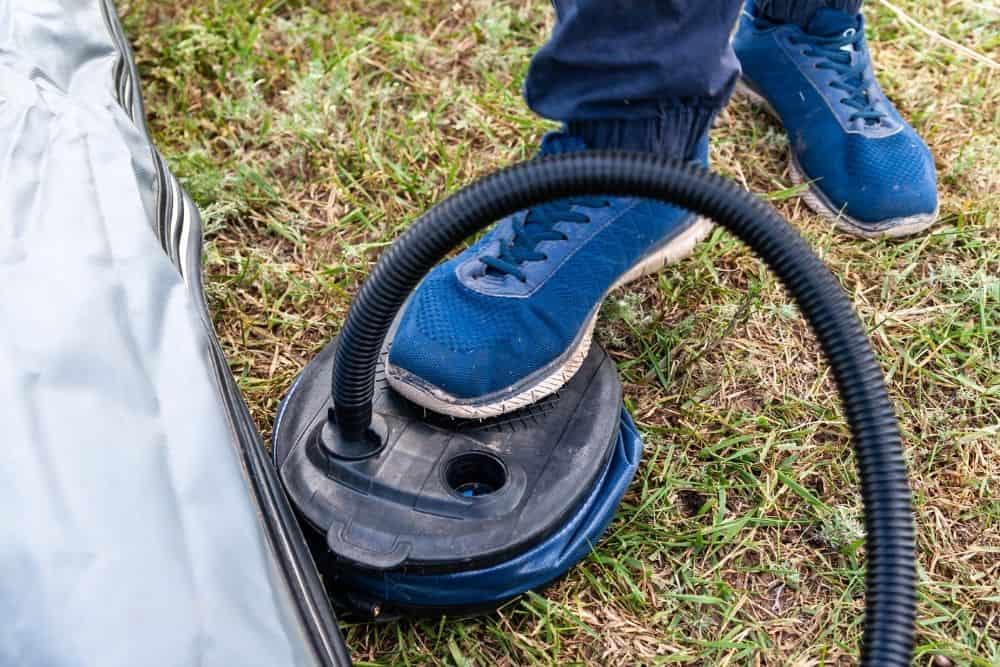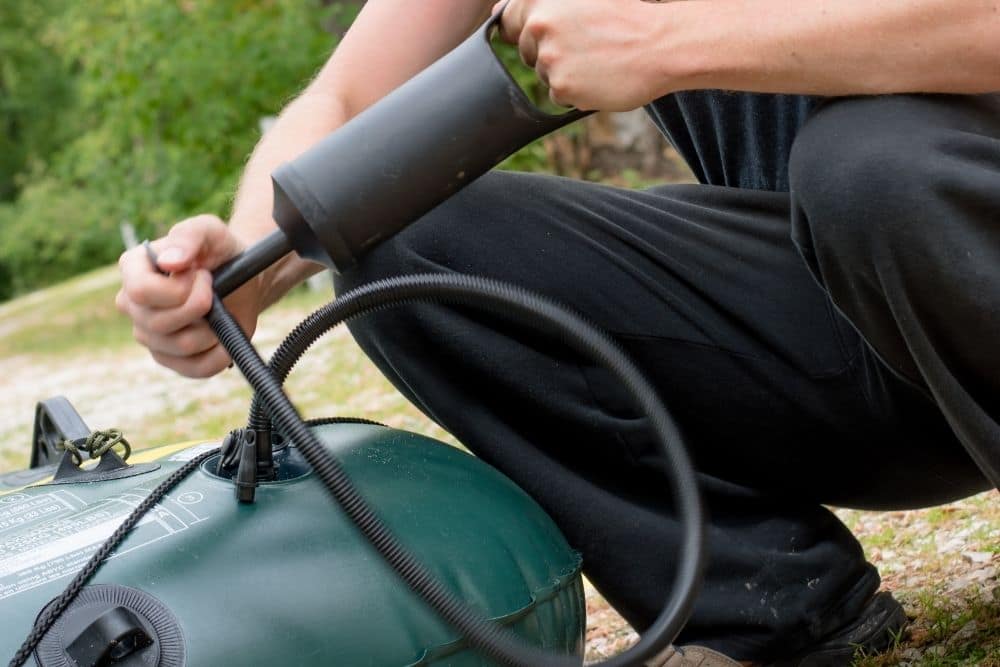Pontoon boats are boats that skim across the water using floats, or pontoons.
In many large pontoon boats, the pontoons have hard shells; however, in some smaller one- or two-person boats, the pontoons may be inflatable.
If you’ve recently purchased one of these small pontoon boats, you may be wondering how to inflate the pontoons.
Do you have to fill them with air, and does the air have to be compressed?
Can you fill pontoons with foam instead?
What is the appropriate air pressure for inflatable pontoons?
And what can you do if your pontoon boat is leaking air?
Keep reading! In this article, we’ll answer all of these questions.
Table of Contents
Do You Have to Fill Pontoons With Air?
In most cases, filling your pontoons with air is probably going to be the cheapest and most time efficient way to inflate them. Your boat most likely came with a hand or foot pump for this purpose (and if it didn’t, you can find one here).

To fill your pontoons with air, you’ll need to follow the directions included with the boat. Chances are, there will be air valves in the pontoon chambers. You will simply attach the pump to these valves one at a time and pump it until the chamber is filled to the proper pressure.
Obviously, this method is going to be pretty time consuming. Instead of using a foot or hand pump, you may be able to use an electric pump, which will be considerably quicker. If you’re buying a new one, make sure it has the right size opening to connect to your boat’s valves.

So yes, filling your pontoons with air is usually best. But do you have to fill them with air?
Technically, the answer is no.
Can You Fill Pontoons With Foam?

Some pontoons are actually filled with a lightweight, marine grade foam. This is especially true of hard-shell pontoons, but foam may be used in inflatable pontoons as well.
Sometimes, the foam is sprayed in. It begins as a liquid and turns to foam once inside the pontoon cavity. This type of foam can be used to repair leaks and increase the buoyancy of your pontoons.
Other types of foam are pre-formed to fit inside pontoons. In this case, it’s important to get the right sized foam inserts for the size of your pontoons.
Keep in mind that not all pontoons are made for use with foam. Most inflatable pontoons are meant to be filled with air, and though most rigid pontoons can be filled with foam, not all of them come with a way to fill the chambers.
You’ll want to find out ahead of time if foam is a good option for your boat. Always check with your owner’s manual before deciding to use foam.
That said, there are several benefits to using foam if your boat will take it. Some types of foam will not only repair leaks in the outer layer of the pontoon, but will also prevent future leaks by providing a sort of inner seal.
In addition, using foam in pontoons will make them extra buoyant. It will also save you the hassle of having to air up the pontoons every time the pressure changes or they start to lose air.
But, as mentioned, foam cannot be used in all pontoons. Even then, filling your pontoons with foam can get expensive.
So the decision of whether to use foam or to simply inflate your pontoons with air will depend on the type of boat you have as well as your specific preferences.
What is the Recommended Pressure For Pontoon Boats?

If you decide to inflate your pontoons with air, you’ll need to make sure not to fill them too full; if you do, the seams may burst.
With that in mind, it’s important to consider the ideal air pressure for pontoons.
As a general rule, you’ll want your air pressure to be around 3 psi (pounds per square inch). Make sure to check your owner’s manual, as this number may vary slightly for different boats.
Even hard-shell pontoons often have a certain amount of air pressure inside. This keeps the material comprising the pontoons from collapsing against the weight of the water.
Both hard-shell and inflatable pontoons should have an air pressure of around 3 psi. But you don’t necessarily need to air up your hard-shell pontoons as you would inflatable pontoons. In fact, forcing compressed air into your pontoons could damage them and isn’t recommended.
Some inflatable pontoons come with a pressure gauge to help you make sure you air them up properly. Anytime your boat needs air, simply use your pump to add air until your pressure gauge is reading 3 psi.
What Can You Do if Your Pontoon is Leaking Air?
An air leak will cause obvious problems if you have inflatable pontoons. The pontoons will become saggy and deflated, causing you to sit low in the water and even take on water. The inflatable chambers may also begin to fill with water, increasing the boat’s weight.
Even hard-shell pontoons can develop leaks if they become cracked or damaged. Though you won’t have to worry about these pontoons deflating, they may still take on water and cause the boat to ride unevenly or dangerously low.
So how can you fix an air leak in a pontoon?
First, you’ll need to find where the air is leaking from. To do this, mix any kind of soap with an equal amount of water in a spray bottle. Spray it all over the pontoon, wait several minutes at least, and see if bubbles start to appear. These will indicate a spot where air is leaking.

Once you have identified the leaks, mark them with a marker so you can find them again.
To repair an inflatable pontoon, use the repair kit that came with the boat. Unfold the repair material, cut a large enough piece to cover the leak, and round off the edges. Remove the sticky backing from the patch and apply according to the manufacturer’s directions.
To repair a hard-shell pontoon, you’ll need to use a plastic-metal putty. Apply it in small amounts according to package directions, let it set, and sand it down.
For some types of leaks, you may also need to apply a layer of epoxy as explained in this article.
Next, apply a layer of primer and, once that has dried, a layer of antifouling paint.
Once each layer has set and dried for the appropriate amount of time, you’re ready to put the pontoon back in the water.
Conclusion
And there you have it!
Filling your pontoons with air or foam is a relatively simple process, but you’ll want to follow the instructions included in your owner’s manual to make sure you do it right for your specific boat.
Remember, keep your inflatable pontoons at roughly 3 psi of pressure or whatever number is appropriate to the boat. Keeping it at the proper pressure will limit your chances of developing leaks.
If you do have a leak though, use the simple techniques discussed above to repair it. With any luck, you’ll be back on the water in no time!

Sarah Hood has been writing for Anchor Travel since 2021. When she’s not writing, she enjoys cooking, singing, and spending time in the great outdoors.

